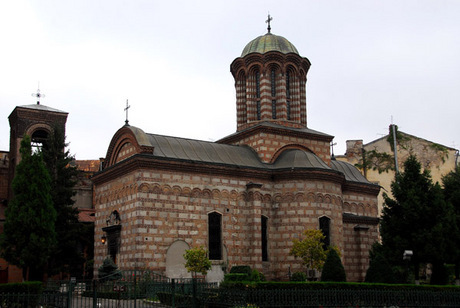The Old Princely Court's Church
The oldest part of Bucharest lies around The Old Princely Court. Built as a place or residence during the rule of Vlad III Dracula in the 15th century, now operates as a museum in the centre of Bucharest. All that remains today are a few walls, arches, tombstones and a Corinthian column.
Next to the palace stands the Old Court Church (Biserica Curtea Veche), dating from 1559 and considered the oldest in Bucharest. For two centuries, the church served as coronation ground for Romanian princes. The Old Princely Court Church, built in 1546-59 during the reign of Mircea Ciobanul (Mircea the Shepherd), is Bucharest's oldest church. The faded 16th-century frescoes next to the altar are originals. The carved stone portal was added in 1715.
Mircea Ciobanul, who ruled Wallachia twice, between 1545-1554 and 1558-1559 respectively, built a church belonging to his princely residence. It is nowadays known as the Church of the Annunciation or St. Antony's Church, the oldest church in Bucharest which preserved its original form.
Built on the place of a former wooden church which burnt up, restored after another fire in 1847, and over again in 1934, by the Commission of Historical Monuments, the church was conceived in the Wallachian architectural style of the 16th century it singles out by its harmony and balance of proportions. It has got a three-cusped design, it is 25m long and 8m wide on the outwards; its narthex is covered by a semicircular vault, and its nave has a belfry. The decoration of its façades is made of face brick stripes alternating with plaster stripes. At cornices, a series of small decorated niches and buttreses which support the outer walls remind one of the Moldavian style of architecture, a fact which may be associated with the influence exerted by Lady Chiajna, Mircea Ciobanul's wife and daughter to Petru Rares. The exterior decoration is made of brick stripes alternating with plaster stripes. The church was restored after a fire in 1847 and then again between the years of 1928 - 1938 by the Commission of Historical Monuments, which tried to bring the church to its original appearance. This church was the coronation place of Wallachia's ruling princes for almost three centuries (from the second half of the 16th century to the first half of the 19th century). The beautiful carved door was added in the early 18th century by Prince Stefan Cantacuzino. The interior has been blackened with time but you can still admire the beautiful frescoes, some dating from the 16th century.
The portal of the church, well-proportioned, and beautifully carved in brancovan style, though probably too adorned as compared to the simplicity of the edifice's façades, has been added by Brâncoveanu's successor to Wallachia's throne, Stefan Cantacuzino, in 1715. In the church, on the left hand side of the portal, facing the apse, there are murals of the church's founders Mircea Ciobanul (whose tombstone is within the church) and his wife, Lady Chiajna; on the right hand side of the portal are to be seen ruling prince Stefan Cantacuzino and his wife, Lady Pauna.
In the church, on the left hand side of the portal, facing the apse, there are murals of the church's founders (whose tombstone is within the church) and his wife, on the right hand side of the portal are to be seen ruling prince and his wife. The altar screen has wrought carvings covered with golden small leaf, the iconostasis is decorated with symbols taken from the Old Testament, whereas the apse holds original frescoes dating back to the 16th century. St. Antony's miracle working icon holds place of pride among the large silver icons of the church. It draws together many people, especially on Tuesday mornings, when the church often becomes too narrow to hold them all. Antony is a popular, benevolent saint, who, seemingly, has never failed to make a believer's wish come true.
The church of the Old Princely Court was the coronation place of Wallachia's ruling princes for almost three centuries (between the 2nd half of the 16th century and the 1st half of the 19th century). In this Romanian "Westminster Abbey", Wallachian princes used to be "unctioned", and receive God's blessing during a solemn ceremony doubled by a popular feast. After the divine service and after having been entrusted with the princely crown, cloack, belt, handjar and sword, on their way out of the church, the newly assigned princely rulers would have to step on the fresh blood of two rams, which, according to an old tradition, would grant them courage and strength.
In front of the church, and resembling its architectural style, there stands the vicarage. Built in 1935 by architect Horia Teodoru, the parish house has its corners decorated with two inlays representing the Annunciation by Nora Steriadi.




